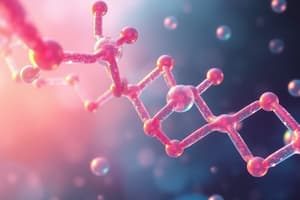Podcast
Questions and Answers
What type of bond links monosaccharides in disaccharides?
What type of bond links monosaccharides in disaccharides?
- Glycosidic bond (correct)
- Hydrogen bond
- Ionic bond
- Peptide bond
Which of the following disaccharides is classified as non-reducing?
Which of the following disaccharides is classified as non-reducing?
- Lactose
- Sucrose (correct)
- Maltose
- Isomaltose
What enzyme is responsible for cleaving glycosidic bonds in disaccharides?
What enzyme is responsible for cleaving glycosidic bonds in disaccharides?
- Lipase
- Lactase
- Glycosidase (correct)
- Amylase
Which disaccharide is referred to as milk sugar?
Which disaccharide is referred to as milk sugar?
What is a significant property of lactose that makes it suitable for baby feeding?
What is a significant property of lactose that makes it suitable for baby feeding?
What type of polysaccharide is starch classified as?
What type of polysaccharide is starch classified as?
Which structure is amylose primarily made of?
Which structure is amylose primarily made of?
What color change does glycogen exhibit when reacting with iodine?
What color change does glycogen exhibit when reacting with iodine?
How does cellulose differ in structure from amylose?
How does cellulose differ in structure from amylose?
What is the primary function of glycogen in animals?
What is the primary function of glycogen in animals?
Flashcards
Disaccharides
Disaccharides
Carbohydrates formed by the linkage of two monosaccharides through a glycosidic bond.
Glycosidic bond
Glycosidic bond
The bond connecting monosaccharides in a disaccharide, often an oxygen atom.
α- or β- glycosidic linkage
α- or β- glycosidic linkage
Different arrangements around the oxygen atom in a glycosidic bond.
Reducing Disaccharides
Reducing Disaccharides
Signup and view all the flashcards
Non-reducing disaccharides
Non-reducing disaccharides
Signup and view all the flashcards
Sucrose
Sucrose
Signup and view all the flashcards
Lactose
Lactose
Signup and view all the flashcards
Maltose
Maltose
Signup and view all the flashcards
Glycosidases
Glycosidases
Signup and view all the flashcards
Lactose suitability for babies
Lactose suitability for babies
Signup and view all the flashcards
Homopolysaccharide
Homopolysaccharide
Signup and view all the flashcards
Heteropolysaccharide
Heteropolysaccharide
Signup and view all the flashcards
Starch
Starch
Signup and view all the flashcards
Amylose
Amylose
Signup and view all the flashcards
Amylopectin
Amylopectin
Signup and view all the flashcards
Glycogen
Glycogen
Signup and view all the flashcards
Cellulose
Cellulose
Signup and view all the flashcards
α(1→4) glycosidic linkage
α(1→4) glycosidic linkage
Signup and view all the flashcards
α(1→6) glycosidic linkage
α(1→6) glycosidic linkage
Signup and view all the flashcards
β(1→4) glycosidic linkage
β(1→4) glycosidic linkage
Signup and view all the flashcards
Study Notes
Carbohydrate Chemistry Lecture 2
- Carbohydrates are classified as monosaccharides, disaccharides, and polysaccharides.
- Monosaccharides are linked by glycosidic bonds, which can be further classified as α- or β-glycosidic bonds
- Disaccharides are composed of two monosaccharides linked by a glycosidic bond.
- Major disaccharides include sucrose, lactose, and maltose.
- Sucrose is glucose + fructose
- Lactose is galactose + glucose
- Maltose is glucose + glucose
- Disaccharides can be reducing or non-reducing, depending on the presence of a free carbonyl group.
- Glycosidic bonds are cleaved by enzymes called glycosidases.
Polysaccharides
- Polysaccharides are composed of hundreds or thousands of carbohydrate units.
- Polysaccharides are not reducing sugars because the anomeric carbons are connected via glycosidic linkages.
- Homopolysaccharides are composed of one type of monosaccharide.
- Heteropolysaccharides are composed of more than one type of monosaccharide.
Starch
- Starch is a polymer of glucose units used as a storage compound in plants.
- Starch is typically insoluble in water but forms colloidal suspensions.
- Starch is composed of two components: amylose and amylopectin.
- Amylose is a straight-chain structure formed by α-1,4-glycosidic bonds between α-D-glucose molecules.
- Amylose forms a blue color on reaction with iodine.
- Amylose is poorly soluble in water but forms micellar suspensions.
- Amylopectin is a branched structure formed by α-1,4-glycosidic bonds and α-1,6-glycosidic branches between α-D-glucose molecules.
- Amylopectin forms a red-violet color on reaction with iodine.
Glycogen
- Glycogen is an animal storage polysaccharide.
- Glycogen structure is similar to amylopectin, differing only in branching frequency.
- Glycogen gives a red-violet color reaction with iodine.
- Glycogen branches occur every 8-12 residues.
Cellulose
- Cellulose is a polymer of β-glucose units joined by β-(1,4) glycosidic linkages.
- Cellulose forms a very rigid structure in extended straight chains that hydrogen bond to each other.
- Cellulose is the most abundant organic compound on earth.
- Found in plant cell walls.
- Animals lack the enzymes needed to digest cellulose, but cellulose provides dietary fiber.
Chitin
- Chitin is a polymer of N-acetylglucosamine units joined by β-(1,4) glycosidic linkages.
- Structurally similar to cellulose but contains acetamide in place of a hydroxy group.
- Provides structural support for exoskeletons of insects and fungi.
Inulin
- Inulin is a polymer of fructose units.
- It's stored in plant tubers like onions and garlic.
Pectin
- Pectins are intercellular substances in young plants, especially abundant in ripe fruits.
- Pectins consist of a-D-galacturonic acid, with some carboxyl groups esterified with methyl alcohol.
Mucopolysaccharides
-
Mucopolysaccharides are polysaccharides composed of simple sugars and sugar derivatives, including amino sugars and uronic acids.
-
Hyaluronic acid is the most abundant mucopolysaccharide.
-
It's a straight chain polymer of D-glucuronic acid and N-acetyl-D-glucosamine (NAG) units.
-
Widely found in various tissues like vitreous body of the eye, umbilical cord, and synovial fluid.
-
Chondroitin is another mucopolysaccharide with a limited distribution.
-
It's similar to hyaluronic acid but contains N-acetyl-D-galactosamine.
-
It is a component of cartilage and cell coats.
-
Chondroitin sulfate and dermatan sulfate are widely distributed and structural components of cartilage, tendons, and bones.
-
Dermatan sulfate has L-iduronic acid in place of D-glucuronic acid in the structure.
-
Keratosulfate has D-galactose in place of the uronic acid component.
-
Heparin is a naturally occurring anticoagulant that prevents blood clots.
-
It's composed of uronic acid and amino sugar (glucosamine) units.
Studying That Suits You
Use AI to generate personalized quizzes and flashcards to suit your learning preferences.




